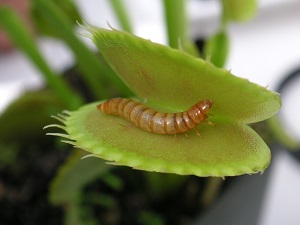
Have you heard of the famous meat-eating plant? It’s called the Venus flytrap.
Insects are attracted to the Venus flytrap for several reasons. The unique shape of its leaves appears inviting and safe. It also offers nectar. As soon as an insect nears the plant, its quick leaves spring to life. In no time at all, the helpless insect finds itself trapped as the two halves of the leaf close shut. After its prey is caught, the plant slowly closes its mouth and uses its sensory glands to test what it has caught. If the prey has protein, the trap fully closes and begins to break down its new food source.
The whole leaf of the Venus flytraps is green, and it is able to photosynthesize. Long bristles on the upper surface of the trap work like triggers with clever technology. However, if a bristle is touched by a raindrop, the trap stays open. If two or more bristles touch together, like if an insect enters the realm, it quickly snaps to catch its victim. The Venus flytrap truly is an intelligent species.
The first living group of Venus flytraps arrived to England from America in the 18th century. Never before had such a unique and amazing plant seen Europe, and it aroused much curiosity.
Even to this day, this plant continues to amaze. Today, Venus flytraps can be potted plants. They come from bogs with water. They don't like tap water because it often contains minerals that reduce the plant’s chances of surviving. Venus flytraps often produce clusters of white flowers, but this does not happen most of the time with indoor groups, especially if they’re fed insects.
The Venus flytrap is a very smart and unique plant. It is not the only meat-eating plant in the world, but it sure is an interesting one.
[Source:
Plant
]

